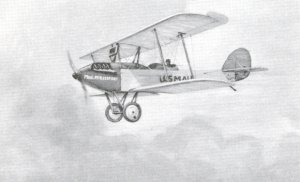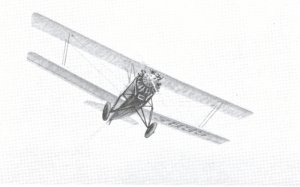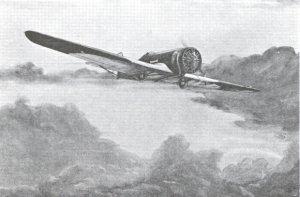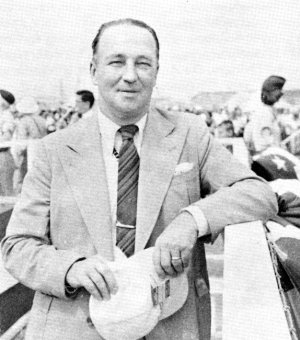
|
|
| The lighted Airway In view of the steady increase in mail loads, augmented by the establishment of several contract feeder routes in the early part of the year 1926, it became apparent to the Department that a plane carrying a much larger load than the DeHaviland was necessary. Competition among various aircraft manufacturers was invited and as a final result 51 Douglas mail planes were purchased, deliveries starting in the month of May 1926. These new planes were capable of carrying more than twice the load carried by the DeHaviland, and also had considerable more speed. As a matter of fact, trips between certain points were made at the rate of 150 to 160 or more miles per hour, but these however were quite infrequent, and only when a stiff tail wind was in evidence.
The record mail trip between Chicago and New York City was made on December 16, 1926, at the rate of 167.5 miles per hour. The fastest mail trip on record was made on January 30, 1927, between Chicago and Cleveland, at the rate of 175.1 miles per hour. The greater cruising radius and speed of the Douglas planes permitted the discontinuance, except possibly in adverse weather conditions, of stops in both directions at Bellefonte, Bryan and Rawlins, and on eastbound trips at Iowa City, North Platte and Rock Springs. An important change in the eastbound transcontinental schedule was also made possible, allowing 1 hour and 15 minutes later departure from the New York terminal. The new planes were put into use between Salt Lake City and New York City, where mail loads were heaviest, the DeHavilands being used from Salt Lake City west. The building of DeHaviland planes at the Repair Depot was discontinued on July 1, 1926, work of that nature being confined from then on to the repairing of old DeHavilands and damaged Douglas planes. The surplus DH planes released were advertised and sold. An important step bearing on the development of air mail traffic was taken by the Department on February 1, 1927, when a new postage rate of 10 cents per half ounce was put into effect, thereby entirely doing away with the complicated zoning system previously in use on the transcontinental and contract routes. The new flat rate entitled transportation between any points in the country, without regard to distance, and was a valuable means of increasing patronage. The Air Mail Service was awarded the Collier trophy for the most important contributions to the development of aeronautics in the year 1922, and on its outstanding record of safety established, and again in the year 1923 for demonstrating the practicability of night flying. The Harmon trophy of the United States, offered for the first time in the year 1926, was awarded by the International League of Aviators to an air mail pilot because of his remarkable record of having flown during that year over 718 hours, without accident, in all kinds of weather, both winter and summer, on regularly assigned trips, 47 per cent of the time being flown at night. It may be stated that in the award of the Harmon trophy the wonderful day in and day out flying record of the air mail pilot was considered more meritorious in the cause of advancing aviation than the flight over the North Pole by Commander Byrd during that year.
It had never been the intention of the Post Office Department, however, to operate the air mail service longer than was necessary to clearly demonstrate the practicability of commercial aviation to the general public, and thereby induce private enterprise to enter the field and eventually take over the operation and development of the transcontinental route, the desired interest was rapidly increasing and in the year 1926 several contract air mail routes were put into operation, and contracts on several more routes were awarded. Interest in commercial aviation, and contract air mail service in particular, was further enlivened when in the spring of 1926 Congress passed a bill, known as the "Air Commerce Act of 1926," which briefly stated, imposed upon the Secretary of Commerce the duty of fostering the development of commercial aviation in the United States. It authorized the Secretary of Commerce, among other things to designate and establish airways, insofar as funds were made available by Congress from year to year, and to establish, operate and maintain along such airways all necessary lights and emergency landing fields. It also provided that at such time as the Postmaster General and Secretary of Commerce by joint order should direct, the airway under the jurisdiction and control of the Postmaster General, together with all emergency landing fields and other air facilities (except airports or terminal landing fields) used in connection therewith, would be transferred to the jurisdiction and control of the Secretary of Commerce, the established airports or terminal landing fields to be transferred to the jurisdiction and control of the municipalities concerned under arrangements subject to approval by the President.
Taking all these happenings into consideration, the Postmaster General concluded that the time was fast approaching, or was actually at hand, when the transcontinental air mail route might be turned over to private contractors and operation successfully and profitably carried on by them. In order to ascertain the response that would be made, advertisements were issued on November 15, 1927, for proposals for service on the transcontinental route by sections: (1) New York to Chicago, and (2) Chicago to San Francisco. A proposal at a satisfactory rate was received on the Chicago to San Francisco section from the Boeing Airplane Company and Edward Hubbard, of Seattle, Wash. (later incorporated as the Boeing Air Transport, Salt Lake City, Utah), was accepted. Service began under their contract July 1, 1927, the Post Office Department relinquishing operation at midnight June 30. As no satisfactory bid was received for the service between New York and Chicago, that section of the route was re-advertised under date of March 8 and the bid of the National Air Transport, Inc., Chicago, Ill., accepted thereunder. This company began service under their contract on September 1, the Post Office Department continuing operation up until that time. In addition to turning over to the contractor operation of service between Chicago and San Francisco on July 1, 1927, another important event in the history of the Government operated air mail service took place on that date when, acting under legislation contained in the Air Commerce Act above referred to, the lighted airway and the radio service were transferred to the jurisdiction and control of the Department of Commerce. The transfer of the radio service included seventeen fully equipped stations with an operating personnel of 44, transfer of the lighted airway included an operating personnel of approximately 102, and the following fields and lights: Emergency landing fields with caretakers in charge
-------------------------------68 Arrangements were made for this transfer of terminal airports to the municipalities at which they were located very shortly after the relinquishment of service on the western part of the route, and the same procedure was followed after relinquishment of service on the eastern part. The buildings at Chicago were located on property owned by the u. S. Veterans Bureau, and at Omaha and San Francisco on property owned by the War Department; ownership of these buildings therefore reverted to the government departments named. A number of the new Douglas planes were sold to air mail contractors, and the balance together with the few remaining serviceable DeHavilands, were transferred to other government departments in need of such equipment. Considerable of the shop material and equipment could be advantageously used in the large post office garages and transfer was accordingly made. The remaining serviceable material, equipment, etc., was listed to the Chief Coordinator for clearance and that desired by other government departments was accordingly transferred. The material and equipment not taken by other branches of the government was listed for sale and sold in the usual manner to the highest bidder. By December 31, 1927, the Department's interests were completely closed out at all fields except Chicago, where only a small quantity of the material and equipment located in the repair depot and warehouse remained to be disposed of. The Post Office Department has reason to be proud of the development of its undertaking and the following tables will clearly illustrate some of the work accomplished from the beginning of service to its complete relinquishment August 31, 1927. From the statement on performance will be noted the remarkable percentage of scheduled miles flown, and in this connection it may be stated that if it were not for severe weather conditions, especially met with during the winter months of the year, such as fog, sleet and blizzards, an almost perfect schedule could be maintained at all times. Of course, weather that was considered impossible to fly through in the early stages was easily flown through during the last few years, but fog still remains the greatest enemy of the pilot and the cause of practically all serious delays and uncompleted trips. Short areas of fog are flown through or over, but is not practicable to fly through or over large areas of dense fog, requiring designated landings to be made therein, with our present equipment and instruments. However, experiments are being continually carried on with a view to finding some effectual means of overcoming this hazard, and it is hoped that such means will be found within the not too far distant future. Attention is also called to the wonderful record
of safety established during the later years of operation, as shown in the
statement of fatalities, etc. A total of 3,108,720 miles were flown before
the last fatality occurred.
Return Home
- Return History Index
- History:
Pages
1,
2, 3
|
History |
Air Mail Pilots
|
Photo
Gallery |
Flight Info
|
Antique Airplanes
|
Members |
|
copyright © 1999 Nancy Allison Wright, President Air Mail Pioneers
|



